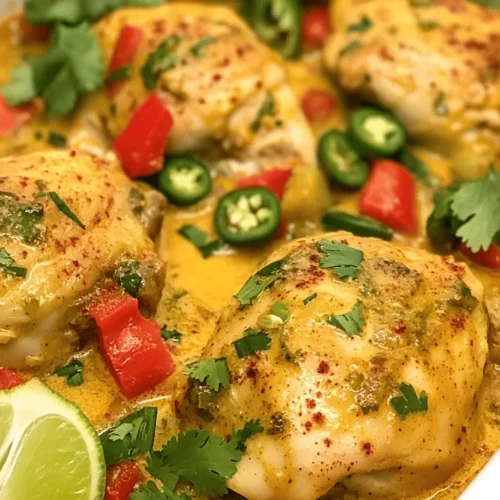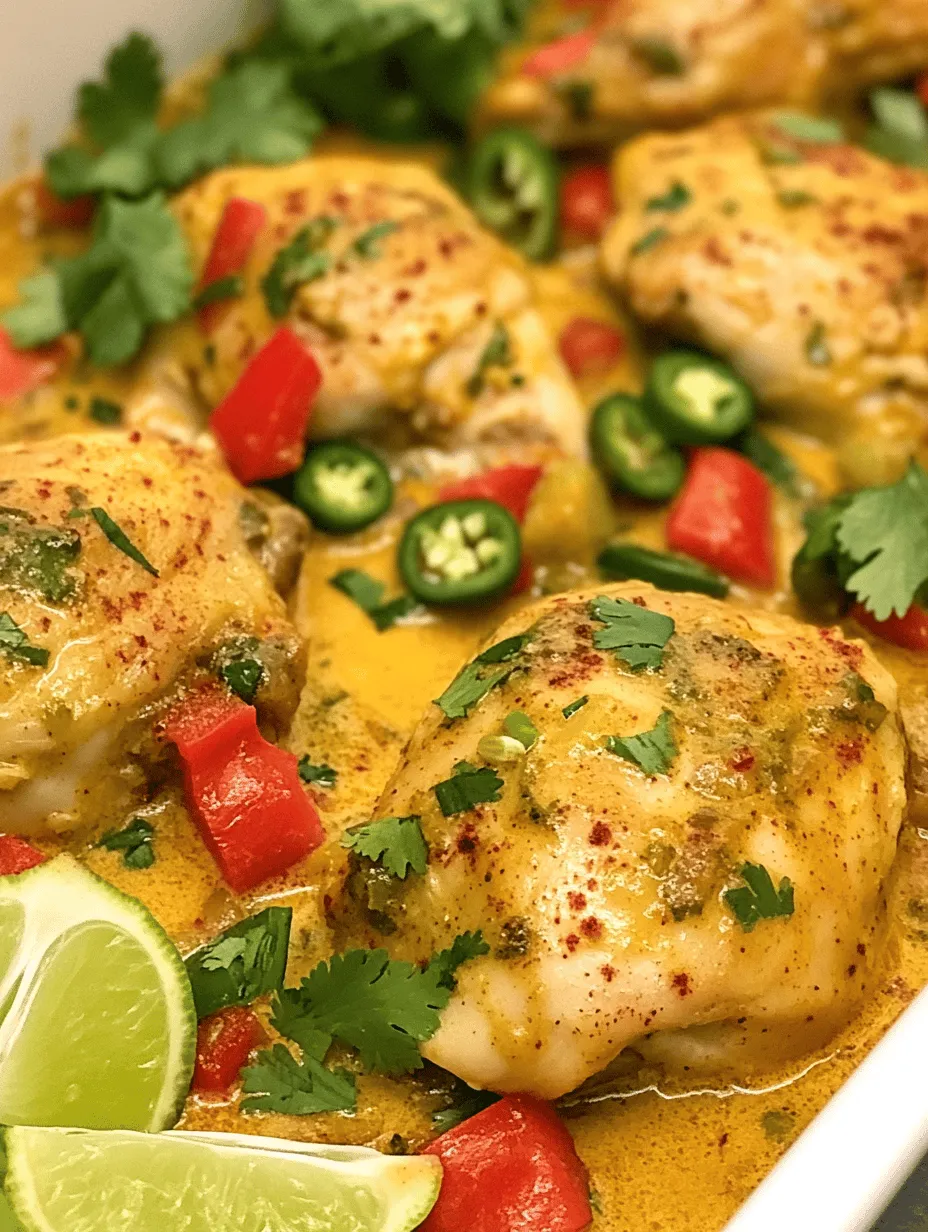Introduction
Spicy Brazilian Coconut Chicken is more than just a dish; it’s a celebration of Brazil’s vibrant culinary landscape. Rooted in the country’s rich cultural heritage, this recipe marries the bold spiciness typical of Brazilian cuisine with the creamy, tropical essence of coconut milk. From the bustling streets of São Paulo to the serene beaches of Bahia, this dish encapsulates the diverse flavors that define Brazilian food. Its origins can be traced back to the coastal regions where coconut palms flourish, and spices are abundant, making it a beloved staple in many Brazilian households.
The unique flavor profile of Spicy Brazilian Coconut Chicken is a delightful journey for the palate. The dish balances the heat from spices and peppers with the soothing creaminess of coconut milk, creating a harmonious blend that excites the senses. This interplay of flavors ensures that it appeals to a wide range of palates, making it an excellent choice for family dinners, gatherings, or even a cozy night in. Whether you are a spice enthusiast or someone who prefers milder flavors, this dish can be easily adjusted to suit your taste, making it incredibly versatile.
As we dive into the intricacies of this recipe, you will discover not only how to create this mouthwatering dish but also the cultural significance behind its ingredients. The following sections will break down the core components of Spicy Brazilian Coconut Chicken, focusing on their origins, health benefits, and the essential techniques that bring this dish to life.
Understanding the Core Ingredients
Creating a memorable Spicy Brazilian Coconut Chicken starts with understanding its key ingredients. Each component plays a vital role in developing the dish’s signature flavor and texture.
Boneless, Skinless Chicken Thighs
The star of this recipe is undoubtedly the boneless, skinless chicken thighs. Unlike chicken breasts, which can dry out quickly, thighs remain juicy and tender even when cooked at higher temperatures. Their rich flavor provides a robust base for the dish, absorbing the spices and coconut milk beautifully. Chicken thighs are also more forgiving in cooking, allowing for a perfect sear without the risk of overcooking.
Coconut Milk
Coconut milk is a fundamental element in Brazilian cooking, often used to add creaminess and depth to various dishes. Its tropical flavor complements the spices used in this recipe, contrasting the heat with a smooth, rich texture. Not only does coconut milk enhance the dish’s taste, but it also offers numerous health benefits. It is rich in essential nutrients, including vitamins C and E, and contains healthy fats that can aid in digestion and support heart health. Additionally, the lactose-free nature of coconut milk makes this dish suitable for those with dairy allergies or lactose intolerance.
Fresh Vegetables
Fresh vegetables are integral to the overall flavor profile of Spicy Brazilian Coconut Chicken. In this dish, onions, bell peppers, and jalapeños add layers of taste and texture. Onions provide a sweet and slightly sharp base, caramelizing beautifully when sautéed. Bell peppers contribute a crisp, refreshing crunch, while jalapeños introduce a lively heat that can be adjusted to your preference. Together, these vegetables create a colorful and nutritious medley that enhances the dish’s appeal.
Importance of Spices
The spice blend used in Spicy Brazilian Coconut Chicken is what truly elevates it to a culinary masterpiece. The combination of paprika, cumin, turmeric, and chili powder not only brings flavor but also offers various health benefits.
– Paprika is known for its mild, sweet flavor and vibrant red color. It adds depth to the dish while providing antioxidants that can help fight inflammation.
– Cumin has a warm, earthy taste that pairs beautifully with chicken, enhancing its natural flavors. It is also rich in iron and can aid digestion.
– Turmeric, with its bright yellow hue, not only adds a distinctive color but is also renowned for its anti-inflammatory properties, making it a powerhouse spice in this recipe.
– Chili powder is essential for that spicy kick, and its heat can be adjusted based on personal preference. It also contains capsaicin, which has been linked to various health benefits, including improved metabolism.
Preparation: The Art of Marinating
Marinating is a crucial step in preparing Spicy Brazilian Coconut Chicken, as it allows the flavors to penetrate the meat deeply. Not only does marinating enhance the taste, but it also helps to tenderize the chicken, ensuring each bite is juicy and full of flavor.
Importance of Marinating Chicken
The process of marinating chicken is essential for flavor enhancement and ensuring moisture retention during cooking. The combination of spices and coconut milk creates a flavorful bath that infuses the chicken thighs with a deliciously complex taste. Marinating also allows the spices to work their magic, breaking down proteins and contributing to a tender texture.
Step-by-Step Guide on How to Effectively Marinate the Chicken
1. Prepare the Marinade: In a mixing bowl, combine coconut milk with the spices (paprika, cumin, turmeric, chili powder), minced garlic, and lime juice. The acidity from lime juice helps to tenderize the chicken while adding a zesty flavor.
2. Add the Chicken: Place the boneless, skinless chicken thighs into the marinade, ensuring they are fully coated. This will ensure every bite is packed with flavor.
3. Cover and Refrigerate: Cover the bowl with plastic wrap or transfer the chicken and marinade into a resealable plastic bag. Refrigerate for at least 1 hour, but for optimal results, aim for 4 to 6 hours. For even greater flavor depth, marinating overnight is ideal.
Recommended Marination Time for Optimal Results
While a minimum of 1 hour is necessary to allow the flavors to infuse, marinating the chicken for 4 to 6 hours yields the best results. If time allows, an overnight marination can elevate the dish to new heights, providing an intensely flavorful experience with every bite. It’s a small investment of time that will pay off in the final outcome.
Cooking Techniques for Perfect Textures
Once the chicken has marinated to perfection, the next step is to utilize effective cooking techniques that will create the ideal textures and flavors in your Spicy Brazilian Coconut Chicken.
Explanation of Sautéing Vegetables
Sautéing vegetables is a vital technique that enhances flavor development and ensures that each component of the dish shines. When sautéing, it’s essential to use medium-high heat, which allows the vegetables to caramelize, releasing their natural sugars and creating a depth of flavor.
1. Heat the Pan: Start by heating a large skillet over medium-high heat. Add a drizzle of olive oil or coconut oil to the pan, allowing it to heat up before adding the vegetables.
2. Add the Onions: Begin with the onions, as they take the longest to cook. Sauté them for about 3-4 minutes until they become translucent.
3. Incorporate Bell Peppers and Jalapeño: Next, add the bell peppers and jalapeños to the pan, sautéing for an additional 3-5 minutes until they are tender yet still crisp. The vibrant colors of the vegetables will not only enhance the dish visually but also contribute to the overall flavor experience.
Cooking Chicken: Tips for Achieving the Perfect Sear
To achieve a perfect sear on the marinated chicken thighs, follow these steps:
1. Preheat the Skillet: Ensure your skillet is hot enough before adding the chicken. A well-heated skillet guarantees a good sear, locking in juices and creating a beautiful crust.
2. Remove Excess Marinade: Take the chicken out of the marinade, allowing excess liquid to drip off. This helps achieve a nice crust when searing.
3. Sear the Chicken: Place the chicken thighs in the skillet, being careful not to overcrowd the pan. Sear each side for about 6-7 minutes until golden brown. Flip only once to avoid losing the crust. The goal is to achieve a caramelized exterior while keeping the inside moist and tender.
4. Finish Cooking: After searing, you can lower the heat and add the remaining marinade to the skillet, allowing the chicken to cook through in the flavorful sauce. Cover the skillet to keep the moisture in, ensuring juicy chicken.
By following these techniques, you will create a dish that not only tastes incredible but also presents beautifully, making it perfect for any occasion. As we continue to explore the depths of Spicy Brazilian Coconut Chicken, you will learn how to bring all these elements together for a truly unforgettable meal.

Creating the Coconut Sauce
To achieve the rich and creamy texture that defines the Spicy Brazilian Coconut Chicken, the coconut sauce is paramount. Coconut milk serves as the heart of this sauce, providing a luxurious base that complements the spices and chicken beautifully. Not only does it add creaminess, but it also brings a subtle sweetness that balances the heat of the peppers and spices.
How to Create the Sauce
1. Sautéing the Aromatics: Begin by heating a tablespoon of olive oil in a large skillet over medium heat. Add finely chopped onions and garlic, sautéing them until they become translucent and fragrant. This step lays the foundation for a flavor-packed sauce.
2. Adding the Peppers: Next, incorporate your choice of chopped bell peppers (red, yellow, or green) and any additional chili peppers for heat. Sauté these until they soften, which usually takes about 5 minutes. The vibrant colors of the peppers not only enhance the dish visually but also contribute to its flavor complexity.
3. Incorporating Coconut Milk: Once the peppers are tender, pour in a can (about 13.5 ounces) of full-fat coconut milk. Stir well to combine all the ingredients. The richness of the coconut milk is essential for creating a sauce that adheres beautifully to the chicken and provides a luscious mouthfeel.
4. Adjusting Consistency: If you prefer a thicker sauce, let it simmer uncovered for a few more minutes to reduce and thicken. Alternatively, if you desire a lighter sauce, add a splash of chicken broth or water to achieve the desired consistency. Always remember to taste as you go; this will help you fine-tune the sauce to your liking.
5. Achieving the Right Balance: To ensure the sauce is perfectly balanced, consider adding a teaspoon of lime juice or tamarind paste for acidity. This will brighten the dish and enhance the flavors. Additionally, season with salt and pepper, and if desired, a pinch of sugar to offset the heat.
Flavor Balancing: Adjustments and Personalization
The key to a memorable Spicy Brazilian Coconut Chicken lies in the ability to adjust flavors to suit your palate. Tasting as you cook is critical; it allows you to make real-time adjustments that elevate the dish.
– Tasting and Adjusting: After combining the coconut sauce with the chicken, don’t hesitate to taste the dish. If you find it needs more spice, consider adding more chili flakes or a dash of hot sauce. Conversely, if it’s too spicy, a bit of sugar or more coconut milk can help mellow the heat.
– Customizing Heat Levels: Depending on your heat tolerance, you can easily adjust the spice levels. For a milder version, remove the seeds from the chili peppers or use a less spicy variety. If you’re seeking an extra kick, add a few dashes of your favorite hot sauce or even some diced jalapeños.
– Exploring Flavor Profiles: Don’t be afraid to experiment with different spices. A sprinkle of smoked paprika or a dash of curry powder can add a unique flair to the dish. Fresh herbs like cilantro or parsley can also be added towards the end of cooking for a bright finish.
Serving Suggestions and Pairings
To showcase the rich flavors of your Spicy Brazilian Coconut Chicken, consider these serving suggestions that enhance the dish’s appeal:
– Rice: A bed of fluffy white or jasmine rice is the most traditional accompaniment. The rice absorbs the flavorful sauce, making each bite irresistible.
– Crusty Bread: For a delightful twist, serve the dish with crusty bread. It’s perfect for soaking up the creamy sauce and adds a rustic touch to your meal.
– Alternatives: For a healthier option, consider serving the chicken over quinoa or cauliflower rice. This not only adds a nutritious element but also provides a gluten-free alternative.
– Garnishes: Enhance your presentation by garnishing the dish with freshly chopped cilantro or parsley and a wedge of lime on the side. This not only adds a pop of color but also allows diners to add a squeeze of lime for an extra burst of flavor.
– Cultural Context: In Brazil, this dish is often served during family gatherings and special occasions. It embodies the vibrant flavors of Brazilian cuisine and reflects the country’s rich culinary heritage. Embracing this cultural context while serving can enhance the dining experience, making it more meaningful.
Nutritional Information and Health Benefits
Understanding the nutritional content of your meal can enhance your cooking experience. Here’s an overview of what you can expect from a serving of Spicy Brazilian Coconut Chicken:
– Nutritional Overview: A typical serving contains approximately 400-500 calories, depending on the portion sizes and specific ingredients used. This dish is rich in protein from the chicken and provides healthy fats from the coconut milk.
– Health Benefits: Coconut milk is known for its health benefits, including anti-inflammatory properties and healthy fat content, which can promote heart health. Additionally, the chicken provides lean protein essential for muscle repair and growth.
– Dietary Considerations: This recipe is naturally gluten-free and dairy-free, making it suitable for individuals with dietary restrictions. For those watching their carbohydrate intake, substituting rice with vegetables or quinoa keeps the meal healthy and balanced.
Conclusion
The Spicy Brazilian Coconut Chicken is more than just a meal; it’s a vibrant exploration of Brazilian cuisine that encapsulates the country’s rich culinary traditions. With its perfect balance of heat and creaminess, this dish is sure to impress family and friends alike.
Encourage yourself to dive into the vibrant tastes of Brazil by trying out this recipe. Don’t hesitate to make it your own—experiment with different spices and adjust the heat levels to create a dish that resonates with your taste preferences. The world of Brazilian cuisine awaits you, and this recipe is just the beginning. Share your cooking experiences and variations, and inspire others to embark on this culinary journey with you!



